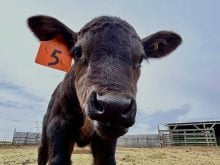Early winter is the best time for many beef producers to switch their cow herds to a specialized “winter” vitamin-mineral premix. Gestating cows need more dietary vitamin A as they move throughout the winter and onto the last few months before calving.
In this way, nobody gets caught short on providing such an essential nutrient to their beef cows. They can avoid common vitamin A deficiency signs such as reduced feed intake, high incidence of disease, edema, diarrhea, poor-quality colostrum (for newborn calves), a high incidence of stillborn/weak calves as well as reproductive and calving problems.
As a beef nutritionist, I have received several farm calls request- ing mineral/vitamin formulas be customized in order to build vitamin A status in bred animals. The amount often exceeds the gestating beef cows’ NRC requirement by 100 to 200 per cent. The accompanying table shows recommended daily vitamin A requirements.
The need for high vitamin A originates from lessons learned years ago that many winter deficiencies are due to variable levels of vitamin A found in pastures during the grazing season, or rapid vitamin degradation in stored forage. Also, significant genetic progress of cattle raised in the last 30 years simply means animals need more vitamin A.

To ensure enough supplemental vitamin A is formulated into a mineral/vitamin premix, I calculate the total amount of vitamin A supplied to each cow, which is based upon the premix’s dietary vitamin A concentration (iu/kg) and its daily feeding rate (grams/head/day).
For example, a feed label of a commercial cow premix might list its vitamin A level as 700,000 iu/kg and it is to be fed at 112 grams (4 oz or 0.25 lb.) to each gestating beef cow. It provides 78,400 iu per head of vitamin A per day. In this case, this final amount exceeds the cow herd’s specific NRC requirement for vitamin A, yet is well below the CFIA maximum allowance of 100,000 iu/head/d for beef cattle.
Read Also

Harvest wraps up and fall work begins
At the Eppich famly ranch in western Saskatchewan, the fall harvest was successful with few breakdowns, cows and calves have been sorted and a new tractor has arrived
Shots will work too
Some producers instead prefer to give vitamin A shots directly to their beef cows to either build them up for a few winter months or reverse a suspected deficiency. In either case, the general recommendation is to inject 1.0-1.5 million iu of vitamin A per head, with the option of periodic injections where warranted.
Regardless of which practice is used, research shows vitamin A is a fat-soluble vitamin which cattle can store in large amounts in their liver. This happens when daily intake is three to five times greater than the average cow’s daily requirement. For example, an average gestating beef cow can store up to four months’ worth of vitamin A requirements in her liver.
Along with symptoms of vitamin A deficiency mentioned earlier, researchers also learned that severely vitamin A-deficient cows usually have a hard time returning to good vitamin A status, even though dietary sources are available. It seems once an animal experiences a shortage, it results in permanent internal damage from failure to metabolize dietary vita- min A as well as reduced liver storage capacity.
It should be noted vitamin A is not a specific nutrient and is actually a generic term (like no-name products), which encompasses several compounds with similar bio- logical activities to a compound called retinol.
Retinol and its biologically active derivatives are not found in common forages and grains, but in nature, these plants contain the yellow beta-carotene, which is converted by enzymes on the small intestine wall to retinol-metabolites. These are absorbed and metabolized to meet a cow’s “vitamin A” requirements. Commercial feed mills use highly bioavailable retinyl acetate or palmitate forms as their main source of vitamin A for cattle.
*Daily NRC requirements are calculated based on 500-pound growing or stressed calves and 1,200-pound cows.
















